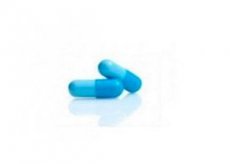Medical expert of the article
New publications
Preparations
Levamisole
Last reviewed: 03.07.2025

All iLive content is medically reviewed or fact checked to ensure as much factual accuracy as possible.
We have strict sourcing guidelines and only link to reputable media sites, academic research institutions and, whenever possible, medically peer reviewed studies. Note that the numbers in parentheses ([1], [2], etc.) are clickable links to these studies.
If you feel that any of our content is inaccurate, out-of-date, or otherwise questionable, please select it and press Ctrl + Enter.

Pharmacodynamics
Levamisole is an imidazole thiazole derivative and is classified as an antihelminthic drug used to treat nematodosis. This active ingredient has a rapid antihelminthic effect, which is manifested by its effect on ganglion-like elements of the nematode type, resulting in the suppression of fumarate dehydrogenase, and in addition, the activity of succinate dehydrogenase is blocked. Depolarizing paralysis also begins in the neuromuscular region of the muscular wall of helminths, due to which the bioenergetic processes of parasite activity are disrupted. Nematodes living in the body are paralyzed, after which they are excreted by intestinal peristalsis during defecation (within 24 hours after taking the tablet of the drug).
Pharmacokinetics
The absorption of the drug from the gastrointestinal tract after oral use is quite rapid. It takes approximately 1.5-2 hours to reach peak plasma levels.
The drug undergoes liver metabolism processes, resulting in the formation of the main metabolites of the drug - p-hydroxy-levamisole together with its glucuronic derivative. The half-life varies between 3-6 hours.
The unchanged component is excreted in the urine (less than 5%) and in the feces (less than 0.2%).
Dosing and administration
Use Levamisole during pregnancy
The use of the medicine during breastfeeding or pregnancy is permitted only if the benefit to the mother is more likely than the occurrence of complications in the fetus or child.
Contraindications
Side effects Levamisole
With a single use of the drug, no side effects are usually observed.
During treatment, short-term, mild and self-limiting disorders may occasionally occur. Among them: development of diarrhea, leukopenia, encephalopathy, agranulocytosis, vomiting or nausea, headaches or abdominal pain, palpitations, convulsions, dizziness and insomnia. Symptoms of intolerance in the form of skin rash or itching, as well as Quincke's edema may occur.
Overdose
After taking the drug in a dosage of more than 600 mg, symptoms of poisoning such as nausea with vomiting, dizziness, diarrhea, headaches, spasms, convulsions, and a feeling of confusion were observed. There is also a possibility of lethargy.
To eliminate these disorders, the gastrointestinal tract should be cleaned (gastric lavage, enema), and symptomatic procedures should be performed, all the while monitoring vital signs for the victim. If an anticholinesterase effect is detected due to intoxication, atropine should be administered to the patient.
Interactions with other drugs
The combined use of drugs with phenytoin implies an increase in its levels in the plasma, due to which its effect is also enhanced.
Combined use with coumarin anticoagulants may prolong the PT level, so anticoagulant doses should be selected very carefully.
When combined with lipophilic drugs (tetrachloromethane with ether, as well as chloroform, amaranth oil and tetrachloroethylene), the toxic properties of the drug may increase.
 [ 43 ]
[ 43 ]
Special instructions
Reviews
Levamisole receives mostly positive reviews about its action in eliminating helminths. However, patients often note that the drug causes the appearance of individual negative reactions - abdominal or headaches, vomiting with nausea, palpitations and diarrhea. Because of this, before using the drug, patients are advised to make sure that they have no contraindications to taking it, and in addition to this, adhere to the prescribed dosages and follow the recommendations prescribed by the attending physician.
Attention!
To simplify the perception of information, this instruction for use of the drug "Levamisole" translated and presented in a special form on the basis of the official instructions for medical use of the drug. Before use read the annotation that came directly to medicines.
Description provided for informational purposes and is not a guide to self-healing. The need for this drug, the purpose of the treatment regimen, methods and dose of the drug is determined solely by the attending physician. Self-medication is dangerous for your health.

